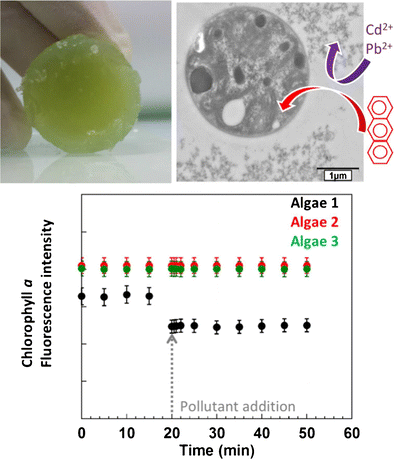Analytical and Bioanalytical Chemistry ( IF 4.3 ) Pub Date : 2017-06-02 , DOI: 10.1007/s00216-017-0405-8 Nada Ben Ahmed , Sylvie Masse , Guillaume Laurent , Jean-Yves Piquemal , Claude Yéprémian , Roberta Brayner , Thibaud Coradin
Optical biosensors for the detection of toxic species in aqueous media were developed via the encapsulation of microalgae in sol–gel matrices. In a first step, the effect of cadmium(II), lead(II), and anthracene on the chlorophyll a fluorescence intensity of Anabaena flos-aquae, Chlorella vulgaris, and Euglena gracilis microalgae in suspension was studied. Complementary ATP-metry measurements demonstrated a direct relationship between optical response and pollutant toxicity, in a cell- and dose-dependent manner. In a second step, microalgae were successfully encapsulated in silicate–colloidal silica nanocomposite matrices. However, a complete loss of cell response to pollutant addition was observed, despite the preservation of cell viability. Introduction of a low amount (5 mol%) of amine- or ethyl-bearing silanes in the matrix formulation allowed the recovery of the sensing capacity of the immobilized microalgae, without impacting on the response time (30 s). Porosimetry and 29Si solid-state NMR spectroscopy showed that the organic moieties are fully integrated into the inorganic network, tuning the ability of the target pollutant to diffuse and reach the encapsulated algae. This versatile strategy could be useful for the easy and fast assessment of contamination levels in polluted waters.

Microalgal biosensors for aqueous contaminants using organically doped silica as cellular hosts
中文翻译:

使用有机掺杂的二氧化硅作为细胞基质的光学微藻生物传感器,用于水污染物
通过将微藻类封装在溶胶-凝胶基质中,开发了用于检测水性介质中有毒物种的光学生物传感器。在第一步骤中,镉的效果(II),铅(II),和蒽对叶绿素一个的荧光强度鱼腥-藻,小球藻,和小眼虫研究了悬浮液中的微藻。补充性ATP量度测量以细胞和剂量依赖性方式证明了光响应和污染物毒性之间的直接关系。第二步,将微藻成功封装在硅酸盐-胶体二氧化硅纳米复合材料基质中。然而,尽管保留了细胞活力,但是观察到细胞对污染物添加的反应完全丧失。在基体配方中引入少量(5 mol%)的含胺或乙基的硅烷可以恢复固定化微藻的传感能力,而不会影响响应时间(30 s)。孔隙率法和29Si固态NMR光谱表明,有机部分已完全整合到无机网络中,从而调节了目标污染物扩散并到达包囊藻类的能力。这种灵活的策略可用于轻松快速地评估污水中的污染水平。

使用有机掺杂的二氧化硅作为细胞基质的微藻类生物传感器,用于水污染物

























 京公网安备 11010802027423号
京公网安备 11010802027423号